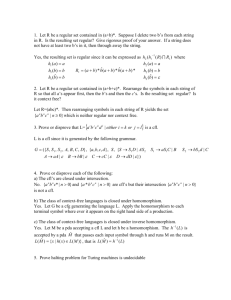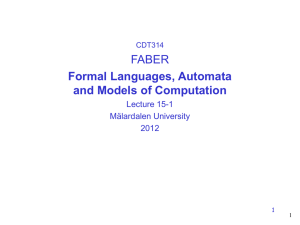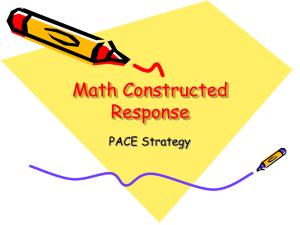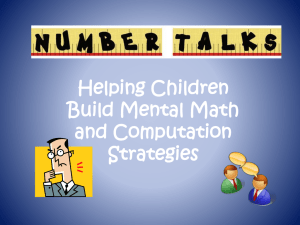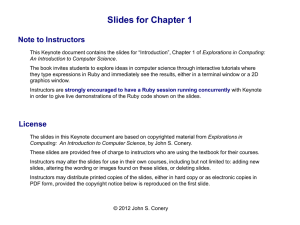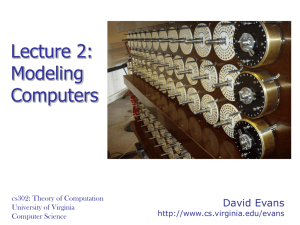Document
advertisement
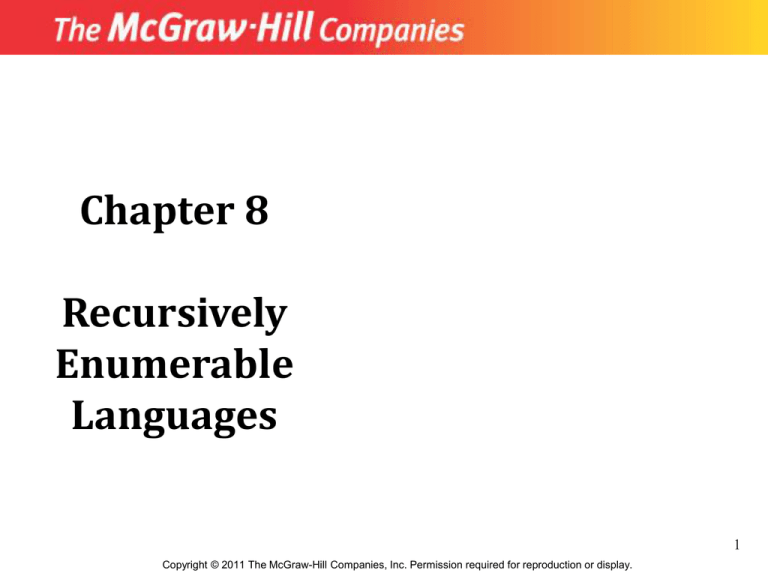
Chapter 8
Recursively
Enumerable
Languages
1
Copyright © 2011 The McGraw-Hill Companies, Inc. Permission required for reproduction or display.
Recursively Enumerable Languages
• Recursively enumerable (r.e.) languages are those that
can be accepted by a TM
• Recursive languages are those that can be decided by
a TM
• Only in the second case are we guaranteed an answer
to the question: Given a string x, is x an element of the
language?
• We will study the relationships between these two
kinds of languages, and we will see that there are
languages that are not r.e., as well as languages that
are r.e. but not recursive
Introduction to Computation
2
Recursively Enumerable and Recursive
• Definition 8.1: A TM T with input alphabet accepts a
language L * if it accepts the strings in L and no
others
• T decides L if T computes the characteristic function
L : * {0,1} that has the value 1 at strings in L and
the value 0 otherwise
• In both cases, the issue is whether the input string is
an element of L. The second approach may be more
informative, however, because a TM accepting L may
not return an answer if the string is not in L
Introduction to Computation
3
Recursively Enumerable and Recursive
(cont’d.)
• Theorem 8.2: Every recursive language is recursively
enumerable
• Theorem 8.3: If L * is accepted by a TM T that
halts on every input string, then L is recursive
• Theorem 8.4: If L1 and L2 are both recursively
enumerable languages over , then L1 ∪ L2 and
L1 ∩ L2 are also recursively enumerable
• Theorem 8.5: If L1 and L2 are both recursive
languages over , then L1 ∪ L2 and L1 ∩ L2 are also
recursive
Introduction to Computation
4
Recursively Enumerable and Recursive
(cont’d.)
• Theorem 8.6: If L is a recursive language over , then
its complement L’ is also recursive
• Theorem 8.7: If L is a recursively enumerable
language, and its complement L’ is also recursively
enumerable, then L is recursive
Introduction to Computation
5
Enumerating a Language
• Definition 8.8: Let T be a k-tape Turing machine for some
k 1, and let L *. We say T enumerates L if it operates
such that the following conditions are satisfied:
– The tape head on the first tape never moves to the left, and
no nonblank symbol printed on tape 1 is subsequently
modified or erased
– For every x L, there is some point during the operation of
T when tape 1 has contents x1 # x2 # … # xn # x # for some
n 0, where the xi’s are also elements of L and
x1, x2, … , xn, x are distinct
– If L is finite, then nothing is printed after the # following
the last element of L
Introduction to Computation
6
Enumerating a Language (cont’d.)
• Theorem 8.9: For every language L *, L is
recursively enumerable if and only if there is a TM
enumerating L, and L is recursive if and only if there
is a TM that enumerates the strings in L in canonical
order
Introduction to Computation
7
Enumerating a Language (cont’d.)
• Proof: we need to show these four things
– If there is a TM that accepts L then there’s one that
enumerates L
– If there is a TM that enumerates L then there’s one that
accepts it
– If there is a TM that decides L, then there is a TM that
enumerates L in canonical order
– If there is a TM that enumerates L in canonical order
then there is a TM that decides L
Introduction to Computation
8
Enumerating a Language (cont’d.)
• To prove these four statements, we’ll make use of the
Church-Turing sequence and just describe an
algorithm, rather than specifying a TM in detail
• We start with the third statement
– If T decides L, then for any string x, we can give x to T
and wait for it to give an answer
– The algorithm for enumerating L is to consider the
strings of * in canonical order, and for each one, add
it to the output only if T says “yes”
Introduction to Computation
9
Enumerating a Language (cont’d.)
• For statement 1, we consider the strings in canonical order, but
“waiting for T to give an answer” might mean waiting forever,
so we make repeated passes
– On each pass, we examine one more string, and for each
string that we’re still unsure about, we consider one more
step in T’s processing of that string
• Statement 2 is easy
– If T enumerates L then an algorithm to accept L is: watch
the computation of T and accept x precisely if T lists x (this
algorithm never returns an answer if x L)
• Statement 4 is almost as easy:
– Watch the computation until either x or a string greater
than x is listed; in the first case, x is in L, and in the second
case it isn’t
Introduction to Computation
10
More General Grammars
• Definition 8.10: An unrestricted grammar is a 4-tuple
G=(V, , S, P), where V and are disjoint sets of
variables and terminals, respectively
– Just as in a CFG, S is the start variable and P is a set of
productions. Here, however, a production can have
the form , where , (V ∪ )* and is any
string containing at least one variable
• It will turn out that unrestricted grammars
correspond to recursively enumerable languages, just
as CFGs correspond to PDAs and regular grammars to
FAs
Introduction to Computation
11
More General Grammars (cont’d.)
• We can continue to use much of the notation
developed for CFGs, but one important difference is
that the assumption S * xAy * z no longer
implies that z = xwy for some string w
• Theorem 8.13: For every unrestricted grammar G,
there is a Turing machine T with L(T) = L(G)
– Proof: construct a TM that accepts L(G)
– It will be simpler to build a nondeterministic TM
Introduction to Computation
12
More General Grammars (cont’d.)
• The TM will contain all the variables and terminals in
G and works as follows
– It moves the tape head to the blank square following
the input string
– During the second phase of its operation, T treats this
blank square as if it were the beginning of the tape,
and the input string is undisturbed
• T simulates a derivation in G nondeterministically as
follows:
Introduction to Computation
13
More General Grammars (cont’d.)
• First the symbol S is written in the square following
the blank
• Each subsequent step involves
– Choosing a production in the grammar
– Selecting an occurrence of , if there is one, in the
string currently on the tape
– Replacing the occurrence of by , which may mean
moving the rest of the string to the right or left
• The final phase is to compare the two strings on the
tape and to accept if and only if they are equal
Introduction to Computation
14
More General Grammars (cont’d.)
• Theorem 8.14: For every TM T with input alphabet ,
there is an unrestricted grammar generating the
language L(T) *
– Proof: for simplicity assume that = {a, b}. The
grammar will have three types of productions:
– Those of type 1 are
S S() | T
T T(aa) | T(bb) | q0()
which generate strings q0()(11)(22)…(kk)
followed by zero or more copies of (). Each pair of
’s is thought of as two copies of a symbol in x *
Introduction to Computation
15
More General Grammars (cont’d.)
• Proof (cont’d.)
– Productions of type 2 allow the moves of T to be
simulated on the second copy x2 of x, while keeping the
first copy x1 unchanged. (The additional variables in
the string, which include state names, , and
parentheses, prevent the derivation from producing a
string of terminals before it has been determined
whether T accepts x.)
– Productions of type 3 allow everything in the string
except x1 to be erased, provided that the computation
of T reaches ha
Introduction to Computation
16
More General Grammars (cont’d.)
• To illustrate the productions of types 2 and 3, consider
the sample transition diagram of T below
• Productions for the first transition, for example, are
q0() ()q1 q0(a) (a)q1 q0(b) (b)q1
• Productions for the third transition look like
( ρ) q1( a) q2 ( ρ) ( $), where , {a, b, } and ρ is
any tape symbol of T. These are more complex because
the transition involves a move to the left
Introduction to Computation
17
More General Grammars (cont’d.)
• We show the moves corresponding to the simulation of T
on the input ba. At each step, the underlined portion is
the part used in the next production.
q0()(bb)(aa)() ⊢ ()q1(bb)(aa)()
⊢ ()(bb)q1(aa)() ⊢ ()q2(bb)(a$)()
⊢ ()(bb)q2(a$)() ⊢ ()(bb)(a$)q3()
⊢ ()(bb)(a$)ha()
• The appearance of ha in the derivation is what will allow
everything except x1, the original input string, to
disappear
Introduction to Computation
18
More General Grammars (cont’d.)
• Productions like (1 2) ha ha (1 2) ha and
ha (1 2) ha (1 2) ha allow the copies of ha to “propagate”
• Productions like
ha (a 2) a ha (b 2) b ha ( 2)
allow us to eliminate everything but ba, which is accepted
• Here is the rest of the derivation:
()(bb)(a$)ha() ⊢
()(bb)ha(a$)ha()
⊢ () ha(bb) ha(a$)ha() ⊢ ha ()ha(bb)ha(a$)ha()
⊢
ha(bb)ha(a$)ha() ⊢
b ha (a$)ha()
⊢
baha() ⊢
ba
Introduction to Computation
19
Context-Sensitive Languages and the
Chomsky Hierarchy
• Definition: A context-sensitive grammar (CSG) is an
unrestricted grammar in which no production is
length-decreasing
– In other words, every production is of the form
, where || ||
• A language is a context-sensitive language (CSL) if it
can be generated by a CSG
• CSGs cannot have -productions, and CSLs cannot
include
• We think of CSLs as a generalization of CFLs
Introduction to Computation
20
Context-Sensitive Languages and the
Chomsky Hierarchy (cont’d.)
• Definition 8.18: A linear-bounded automaton (LBA) is
a nondeterministic TM with this exception:
– There are two extra tape symbols, [ and ]
– The initial configuration of M corresponding to input x
is q0[x]
– During its computation, M is not permitted to replace
either of these brackets or to move its tape head to the
left of the [ or to the right of the ]
Introduction to Computation
21
Context-Sensitive Languages and the
Chomsky Hierarchy (cont’d.)
• Theorem 8.19: If L * is a CSL, then there is an LBA
that accepts L
– We can follow the proof of Theorem 8.13, except that
instead of being able to use the space to the right of the
input string on the tape, the LBA must use the space
between the two brackets
– It can do this by converting individual symbols into
symbol pairs so as to simulate two tape “tracks”
Introduction to Computation
22
Context-Sensitive Languages and the
Chomsky Hierarchy (cont’d.)
• If L * is accepted by a LBA M, then there is a CSG
generating L - {}
• The proof is similar to that of Theorem 8.14
– For details, see book
• The four levels of language we have seen so far
correspond to the Chomsky Hierarchy
Introduction to Computation
23
Context-Sensitive Languages and the
Chomsky Hierarchy (cont’d.)
• The Chomsky Hierarchy
Type Languages
(Grammars)
Form of
Productions
Accepting
Device
3
Regular
A aB, A
Finite
Automaton
2
Context-free
A
Pushdown
Automaton
1
Contextsensitive
with || ||
LBA
0
Unrestricted
Turing
machine
Introduction to Computation
24
Context-Sensitive Languages and the
Chomsky Hierarchy (cont’d.)
• Theorem 8.22: Every CSL is recursive
• Proof: Let G be a CSG generating L
– Theorem 8.19 says that there is an LBA M accepting L
– It suffices to show that there is a nondeterministic TM
T1 accepting L such that no input string can possibly
cause T1 to loop forever
– We may consider M to be a nondeterministic TM T,
which begins by inserting the markers [ and ] in the
squares where they would be already if we were
thinking of T as an LBA
Introduction to Computation
25
Context-Sensitive Languages and the
Chomsky Hierarchy (cont’d.)
• T1 is constructed as a modification of T
• T1 also begins by placing the markers on the tape
• Just like T, T1 performs the first iteration in a
simulated derivation in G by writing S in the first
position of the second track
• Before the second iteration, however, it moves to the
blank portion of the tape after the right marker and
records the string S obtained in the first iteration
Introduction to Computation
26
Context-Sensitive Languages and the
Chomsky Hierarchy (cont’d.)
• In each subsequent iteration it performs the
following four steps (the first three the same as T)
– It selects a production
– It attempts to select an occurrence of in the current
string; if it is unable to, it compares the current string
to the input x and accepts if they’re equal, rejects if
they’re not
Introduction to Computation
27
Context-Sensitive Languages and the
Chomsky Hierarchy (cont’d.)
• Four steps (cont’d.)
– If it can select an occurrence of , it replaces it by ,
and rejects if this would result in a string longer than
the input
– If it successfully replaces by , it compares the new
current string with the strings it has written in the
portion of the tape to the right of ]; it rejects if there’s a
match, and otherwise writes the new string after the
most recent entry
Introduction to Computation
28
Not Every Language is Recursively
Enumerable
• We will now consider languages over an alphabet
and TMs with input alphabet
– We will show that there are more languages than TMs
to accept them. It follows that there must be many
languages not accepted by any TM
• The first step is to explain how it makes sense to talk
about one infinite set being larger than another
• We’ll formulate two definitions
– What it means for two sets to be the same size
– What it means for one to be larger than another
Introduction to Computation
29
Not Every Language is Recursively
Enumerable (cont’d.)
• For finite sets, this is easy, because we know how to say
that one number is equal to or bigger than another.
• Definition 8.23: In general, two sets A and B are the same
size if there is a bijection f : A B. A is larger than B if
some subset of A is the same size as B but A itself is not
• Definition 8.24: A set A is countably infinite if there is a
bijection f : ℕ A, or a list a0, a1, … of elements of A such
that every element of A appears exactly once in the list
– A is countable if A is either finite or countably infinite
Introduction to Computation
30
Not Every Language is Recursively
Enumerable (cont’d.)
• Theorem 8.25: Every infinite set has a countably
infinite subset, and every subset of a countable set is
countable
– For proof, see book
• Even though the set ℕ ℕ seems much larger than ℕ,
it is countable and therefore the same size as ℕ
• We can see this by forming a two-dimensional array
with all the ordered pairs (i, j) and starting a spiral
path at (0,0) that hits each ordered pair. This is a
way of listing the elements of ℕ ℕ
Introduction to Computation
31
Not Every Language is Recursively
Enumerable (cont’d.)
• The set 2ℕ is uncountable. The proof uses a
diagonalization argument
– For every list A0, A1, … of subsets of ℕ, we can define
the set A as follows:
A = {n ℕ | n ∉ An}
– Then for every n ℕ, A ≠ An, because n is an element
of A if and only if it is not an element of An
– The conclusion is that A cannot be one of the subsets in
the list, which means that there can be no list
containing all the subsets of ℕ
Introduction to Computation
32
Not Every Language is Recursively
Enumerable (cont’d.)
• Here’s the reason we call this argument a diagonal
argument:
– Subsets of ℕ can be represented by infinite sequences
of 0’s and 1’s. For example,
↔ 0 0 0 0 0 0 0 0 0 …
ℕ
↔ 1 1 1 1 1 1 1 1 1 …
{0, 3, 4}
↔ 1 0 0 1 1 0 0 0 0 …
{1, 3, 5, …} ↔ 0 1 0 1 0 1 0 1 0 …
• Let each set Ai in the list be represented as follows:
Ai ↔ ai, 0 ai, 1 ai, 2 ai, 3 …
Introduction to Computation
33
Not Every Language is Recursively
Enumerable (cont’d.)
• Then the set A was constructed by looking at the
diagonal entries (underlined)
A0 ↔ a0,0 a0,1 a0,2 a0,3 a0,4 …
A1 ↔ a1,0 a1,1 a1,2 a1,3 a1,4 …
A2 ↔ a2,0 a2,1 a2,2 a2,3 a2,4 …
A3 ↔ a3,0 a3,1 a3,2 a3,3 a3,4 …
and reversing them. For example, A contains 0 if and
only if A0 doesn’t; i.e., A ↔ a0 a1 a2 a3 …
where a0 is the opposite of a0,0, and in general, ai is
the opposite of ai,i
Introduction to Computation
34
Not Every Language is Recursively
Enumerable (cont’d.)
• Theorem 8.32: Not all languages are recursively
enumerable
– In fact, the set of languages over {0,1} that are not
recursively enumerable is uncountable
• We showed that the set of subsets of ℕ is uncountable,
and we observed that because {0,1}* is the same size as ℕ,
it follows that the set of languages over {0,1} is
uncountable
• But the set of recursively enumerable languages over
{0,1} is countable: each one can be accepted by a TM, and
we can list the TMs T by listing the strings e(T) that
represent them
Introduction to Computation
35
